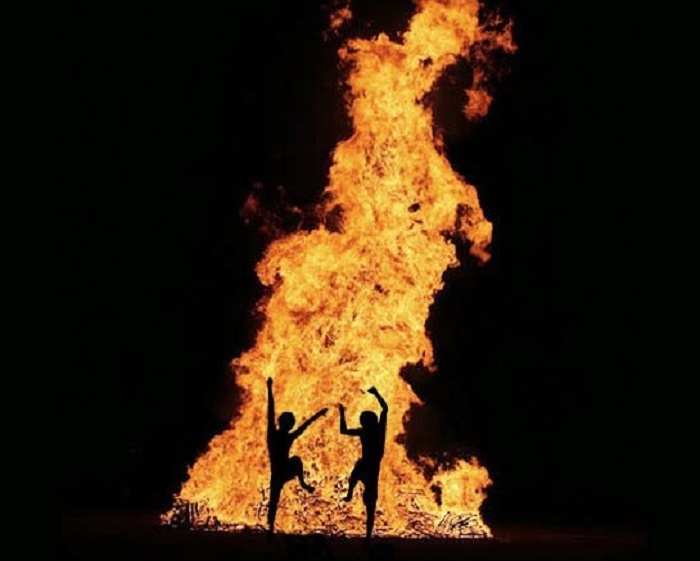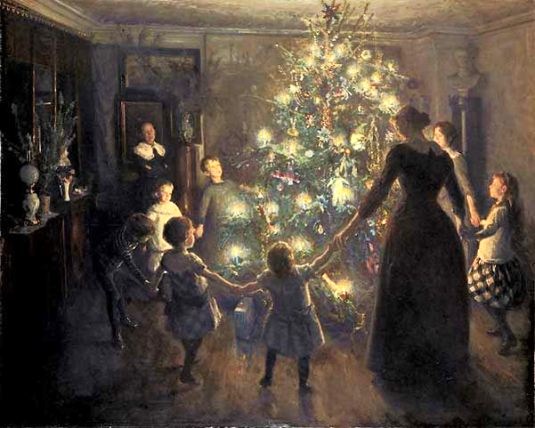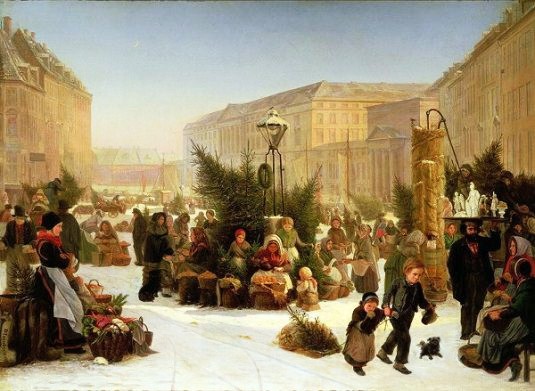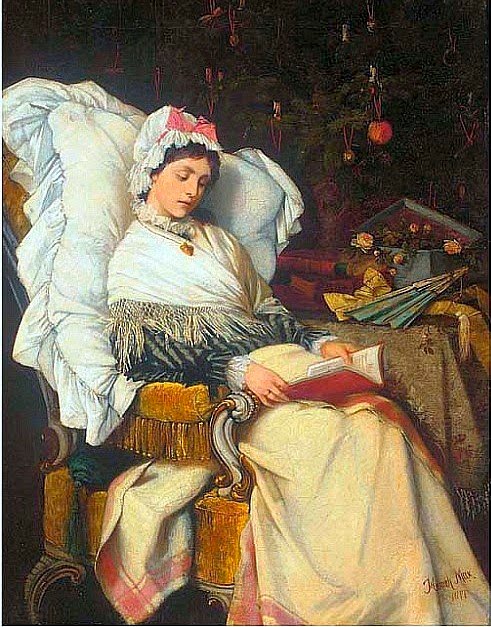A 1660 English illustration from A Book of Roxburghe Ballads. This particular ballad is The Merry Boys of Christmas or The Milk-Maids New-Years-Gift.
""Mark Stoyle investigates popular resistance to the Puritan assault on Christmas during the 1640s and 1650s...As the year 1645 limped towards its weary close, a war-torn England shivered beneath a thick blanket of snow. A few months earlier, parliament’s New Model Army, led by Sir Thomas Fairfax and Oliver Cromwell, had routed the forces of Charles I at the battle of Naseby. Although that defeat had struck the king’s cause a mortal blow, the royalists still refused to surrender, and the bloody Civil War which had divided the country ever since 1642 continued to rage.
"Under constant pressure from the armies of both sides to supply them with money, clothing and food, few Englishmen and women can have been anticipating a particularly merry Christmas. Yet, for those who lived in the extensive territories which were controlled by the king’s enemies, there was to be no Christmas this year at all – because the traditional festivities had been abolished by order of the two Houses of Parliament sitting at Westminster.
"From Charles’s beleaguered wartime capital in Oxford, the royalist satirist John Taylor – by now in his mid-60s, but nevertheless one of the king’s most indefatigable literary champions – issued a cry of anguish at this assault on England’s time-honoured customs. All of the “harmless sports” with which people had long celebrated Christ’s nativity
“are now extinct and put out of use… as if they had never been,” Taylor lamented in his pamphlet The Complaint of Christmas, and “thus are the merry lords of misrule suppressed by the mad lords of bad rule at Westminster”.
"So why had the parliamentarians decided to wage war on Christmas – and how did those, like Taylor, who were determined to defend the traditional celebrations, fight back?
"The attack on the feast of Christmas had deep roots. Long before the Civil War began, many zealous Protestants, or ‘Puritans’, had been troubled both by the boisterous nature of the festivities which took place at Christmas and by the perceived association of those festivities with the old Catholic faith. During the early 1600s, most English Puritans had been prepared to tolerate Christmas. Following the rebellion of the Presbyterian Scots against Charles I in 1637, however, all this was to change.
"The Scottish Kirk, which was itself fiercely Protestant, had abolished Christmas as long ago as the 1560s and, although James I had managed tentatively to restore the feast in his northern kingdom in 1617, it was banned there once again after his son’s defeat by the Scots in 1640.
"From this time onwards, attitudes towards Christmas among English Puritans began to harden. And as political tensions between Charles I and his opponents in parliament rose during 1641 so a handful of Puritan extremists took it upon themselves to abandon the celebration of Christmas.
"Following the outbreak of full-scale Civil War between king and parliament in 1642, John Taylor became one of the first to allude in print to the radicals’ decision to dump Christmas. In a satirical pamphlet published in January 1643 – a pamphlet which was clearly intended to appeal to a wide popular audience – Taylor provided his readers with the text of A Tub Lecture, which, he claimed, had been preached by a godly joiner to a group of Puritans at Watford
“on the 25 of December last, being Christmas day”.
"In this fictitious address, the ‘lecturer’ is shown assuring his audience that they should not “conceive of me to be so superstitious, as to make any conscience of… this day, because the Church hath ordained [it]” to be a holy feast.
“No, God forbid I should be so profane,” the ‘lecturer’ goes on,
“rather it is a detestation of their blindness that have brought me hither this day, to enlighten you… [and] I give you to understand that the very name of Christmas is idolatrous and profane, and so, verily, are the whole 12 days [of Christmas] wherein the wicked make daily… sacrifices to riot and sensuality”.
"Here, Taylor was hinting to his readers that the godly parliamentarians posed a potential threat to Christmas itself. Eight months later, that threat was to become all too real.
1600s woodcut of Christmas celebration
"Seizing the initiative
"One of the clauses of the ‘Solemn League and Covenant’ which parliament signed with the Scots in September 1643 stated that, in exchange for Scottish military assistance against the king, MPs would ensure that further “reformation” of the Church of England took place. As Ronald Hutton has observed, this clause encouraged religious radicals on the ground to seize the initiative and to attack those aspects of the traditional ecclesiastical calendar which they disliked.
"Three months later, a number of Puritan tradesmen in London opened up their shops for business on 25 December in order to show that they regarded this day as no different from any other, while several London ministers kept their church doors firmly shut. Meanwhile, many MPs turned up to sit in the parliament house, thus making their own disdain for the customary Christmas holiday very clear.
"During the following year, moreover – when Christmas Day happened to coincide with one of the monthly fast days upon which parliament’s supporters were enjoined to pray for the success of their cause – MPs ordered, not only that the fast day should be “observed” instead of the traditional feast, but also that the fast should be kept
“with the more solemn humiliation, because it may call to remembrance our sins, and the sins of our forefathers, who have turned this feast, pretending [to] the memory of Christ, into an extreme forgetfulness of him, by giving liberty to carnal and sensual delights”.
"In January 1645 the final nail was hammered into Christmas’s coffin, when parliament issued its new Directory for the Public Worship of God, a radical alternative to the established Book of Common Prayer, which made no reference to Christmas at all. Thus the way was paved for the ‘anti-Christmas’ of 1645 – a day upon which, in Taylor’s words, a man might pass right through the parliamentary quarters, and
“perceive no sign or token of any holy day”.
"The parliamentarians had abolished the high point of the English ritual year, and the cancellation of Christmas aroused huge popular resentment – not just in the royalist camp, but in the districts controlled by parliament, too. As early as December 1643, the apprentice boys of London rose up in violent protest against the shop-keepers who had opened on Christmas Day, and, in the words of a delighted royalist,
“forced these money-changers to shut up their shops again”.
"There were further dark mutterings the next year. On 24 December 1644, the editor of a pro-parliamentarian news-pamphlet expressed his support for the MPs’ decision to favour the monthly fast over the traditional feast, but admitted that
“the parliament is cried out on” by the common people as a result, with incredulous shouts of
“What, not keep Christmas? Here’s a Reformation indeed!”
"Many ordinary Londoners continued to show a dogged determination to keep Christmas special during the following year, and John Taylor’s decision to rush into print at this time with his Complaint of Christmas – a work which bore the same title as a pamphlet urging the enthusiastic observance of the mid-winter feast, which he had published as long ago as 1631 – was clearly motivated by a desire to stir up popular resentment against the parliamentarian leadership, as well as to turn a quick profit for its poverty-stricken author.
"How far Taylor succeeded in these aims it is impossible to say, but his satire quickly provoked a parliamentarian counter-satire entitled The Arraignment, Conviction and Imprisoning of Christmas. Published in January 1646, this publication took great pleasure in conflating Taylor himself with the symbolic character of
‘old Christmas Day’ whose persona the royalist writer had assumed in his own previous pamphlets. In one passage, Taylor/‘old Christmas Day’ – here described as
“an old, old, very old grey-bearded gentleman” – is portrayed sitting dejectedly in the midst of the king’s shrinking territories, while desperately urging
“all you that ever think to see Christmas again, stick to me now close!”
"Any lingering hopes on the part of the royalists that popular anger at the abolition of Christmas might somehow transform their military fortunes were soon to be dispelled. During early 1646, Charles I’s remaining field forces melted away almost as fast as the winter snow and by April the game was clearly up for the king. In the closing verse of a contemporary ballad, a gloomy royalist writer suggested that the collapse of the king’s cause had sealed the fate of Christmas itself, remarking: “To conclude, I’ll tell you news that’s right, Christmas was killed at Naseby fight.”
"Yet matters were not so simple, for, even though the king’s armies had been beaten out of the field and he himself had fallen into the hands of his enemies, most Englishmen and women continued to cling to their traditional Christmas customs. So strong was the popular attachment to the old festivities, indeed, that during the postwar period a number of pro-Christmas riots occurred. In December 1646, for example, a group of young men at Bury St Edmunds threatened local tradesmen who had dared to open their shops on Christmas Day, and were only dispersed by the town magistrates after a bloody scuffle.
"Pro-Christmas riots
"Worse was to follow in 1647 – despite the fact that, on 10 June that year, parliament has passed an ordinance which declared the celebration of Christmas to be a punishable offence. On 25 December 1647, there was further trouble at Bury, while pro-Christmas riots also took place at Norwich and Ipswich. During the course of the Ipswich riot, a protestor named ‘Christmas’ was reported to have been slain – a fatality which could be regarded as richly symbolic, of course, of the way that parliament had ‘killed’ Christmas itself.
"In London, a crowd of apprentices assembled at Cornhill on Christmas Day, and there
“in despite of authority, they set up Holly and Ivy” on the pinnacles of the public water conduit. When the lord mayor despatched some officers
“to pull down these gawds,” the apprentices resisted them, forcing the mayor to rush to the scene with a party of soldiers and to break up the demonstration by force.
"The worst disturbances of all took place at Canterbury, where a crowd of protestors first smashed up the shops which had been opened on Christmas Day and then went on to seize control of the entire city. This riot helped to pave the way for a major insurrection in Kent in 1648 that itself formed part of the
‘Second Civil War’ – a scattered series of risings against the parliament and in favour of the king, which Fairfax and Cromwell only managed to suppress with great difficulty.
"Following parliament’s victory in the Second Civil War and the execution of Charles I in 1649, demonstrations in favour of Christmas became less common. There can be no doubt that many people continued to celebrate Christmas in private, and in his pamphlet The Vindication of Christmas (1652), the tireless John Taylor provided a lively portrait of how, he claimed, the old Christmas festivities were still being kept up by the farmers of Devon.
The Vindication of Christmas 1652
"Nevertheless, recent scholarship has shown that, as time went by, Christmas effectively ceased to be celebrated in the great majority of churches. It was ironic, to say the least, that while the godly had failed to suppress the secular Yuletide festivities which had vexed them for so long, they had succeeded in ending the religious observance of Christmas!
Following Cromwell’s installation as lord protector in 1653, the celebration of Christmas continued to be proscribed. While he had not been personally responsible for ‘cancelling Christmas’ in the first place, it is evident that both Cromwell and the other senior members of his regime were behind the ban, frequently transacting government business on 25 December as if it were a day just like any other.
"Only with the restoration of the monarchy in 1660 was
‘old Christmas Day’ finally brought back in from the cold, to widespread popular joy. John Taylor had died some years before, but if he could have foreseen that, two centuries later, Charles Dickens would be reprising the role which Taylor had made his own – that of the mouthpiece of the
‘true Christmas spirit’ – and that a century and a half later still, the celebration of Christmas would remain as ubiquitous in England and Wales as ever, he would doubtless have felt that his labours had been worthwhile.
"The defenders of Christmas had weathered the storm."
Submitted by Emma McFaron







.JPG)












.+Feast+of+St+Nicholas+1665.jpg)
+A+traveling+family+of+beggars+is+rewarded+by+poor+peasants+on+Christmas+Eve+1834.jpg)
,+Christmas+Eve.jpg)


+Christmas+Morning+1800s.jpg)

+Hanging+the+Mistletoe+1892.jpg)






+The+Christmas+Tree+1911.jpg)



+Katya+in+Blue+Dress+by+Christmas+Tree+1922.jpg)
++The+Christmas+Hamper+1874.jpg)


,+Christmas+Morning+1844.jpg)
+Children+Anticipating+the+Christmas+Feast+1840.jpg)
+A+Christmas+Dole+1800s.jpg)
,+Under+the+Mistletoe+1865.jpg)
+Distributing+Christmas+Presants+1913.jpg)
+Christmas+1939.jpg)

+Christmas+Morning+Service+1908.jpg)
++Santa+with+Toys+1910-20.jpg)
+Christmas+Spirit+1921.jpg)
+Christmas+1903-04.jpg)
+Christmas+1910.jpg)
+Christmas+Eve+1927.jpg)